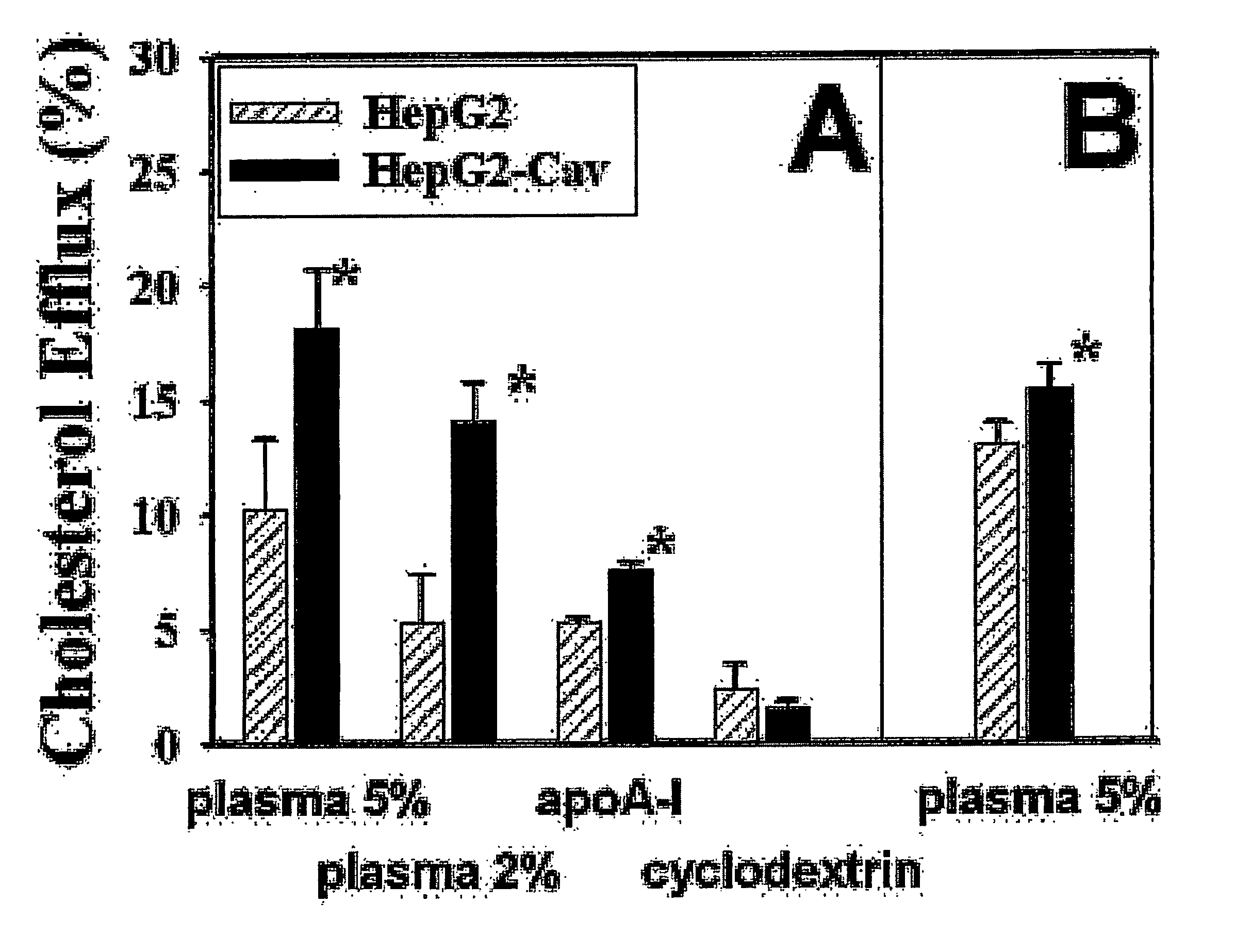Cholesterol efflux and uses thereof
a technology of cholesterol and efflux, which is applied in the direction of antibody medical ingredients, peptide/protein ingredients, and metabolic disorders, etc., can solve the problems of halting the progression of atherosclerosis, reducing the expression and/or activity of cyp27, and deprived vital organs of blood supply
- Summary
- Abstract
- Description
- Claims
- Application Information
AI Technical Summary
Benefits of technology
Problems solved by technology
Method used
Image
Examples
example 1
Expression of Sterol 27-hydroxylase (CYP27A1) Enhances Cholesterol Efflux
1. Methods
a) Cells.
[0148] CHOP-C4 cells were grown in RPMI 1640 medium containing 10% FBS, 2 mM L-glutamin, penicillin / streptomycin (50 units / ml) and 0.2 mg / ml G418. The day before transfection, cells were plated in 12 well plates at a density of 0.6×105 cells per well. Transfection was performed with DEAE-Dextran as described in Albiston, A. L., Obeyesekere, V. R., Smith, R. E., and Krozowski, Z. S. (1994) Mol. Cell. Endocrinol. 105, R11-17 using 200 ng of plasmid DNA (CYP27A1 in pcDNA1 or pcDNA1 alone) per well. CYP27A1 was isolated from a human kidney cDNA library during studies of progesterone metabolism using a screening protocol previously described for the isolation of 11 βHSD2 (Albiston, A. L et al (1994)).
b) Cholesterol Acceptors.
[0149] Blood from healthy normolipidemic volunteers was collected in saline containing streptokinase (Sigma, final concentration 150 units / ml) and plasma was isolated ...
example 2
Expression of Caveolin-1 Enhances Cholesterol Efflux in Hepatic Cells
(a) Cells
[0156] HepG2 cells were cultured in DMEM, 10% fetal bovine serum, 100 μg / ml penicillin / streptomycin and 2 mM glutamine. The cells were seeded at a density of 1×106 cells per well in a 6-well tissue culture plate and for 24 hours until the cells are 60-80% confluent.
[0157] To obtain stable transfectants, HepG2 cells were transfected with pIRES2-EGFP / caveolin-1 (Clontech) plasmid, using LipofectAMINE PLUS Reagent (Invitrogen) in serum-free medium for 5 hours at 37° C. according to manufacturer recommendations. Transfection medium was removed and fresh complete growth medium was added. Twenty-four hours post transfection, cells in one well were split into a 9-cm dish in medium containing 500 μg / ml G418 and cultured for 3-4 days until G-418-resistant colonies were clearly evident. Individual colonies were picked into 24 well plates to continue incubation with G418 selection medium. Individual colonies were...
example 3
Expression of Sterol 27-hydroylase (CYP27A1) Enhances Cholesterol Efflux in Macrophages
[0177] Macrophages were cultured and transfected the same as for the CHOP cells in Example 1 except that after transfection, 0.5 μM 5-azacytidine was included in all further incubations. Transfection of macrophages with high efficiency was always a difficult task. No more than 20% of cells were transfected. However it was found that in most cells the CMV promoter was rapidly silenced by methylation. Accordingly, a demethylation agent, 5-azacytidine, was added to the cells which then expressed CYP27. Panels A and B in FIG. 11 are actually transfected cells, but not treated with 5-azacytidine.
[0178] The discussion of documents, acts, materials, devices, articles and the like is included in this specification solely for the purpose of providing a context for the present invention. It is not suggested or represented that any or all of these matters formed part of the prior art base or were common ge...
PUM
 Login to View More
Login to View More Abstract
Description
Claims
Application Information
 Login to View More
Login to View More - Generate Ideas
- Intellectual Property
- Life Sciences
- Materials
- Tech Scout
- Unparalleled Data Quality
- Higher Quality Content
- 60% Fewer Hallucinations
Browse by: Latest US Patents, China's latest patents, Technical Efficacy Thesaurus, Application Domain, Technology Topic, Popular Technical Reports.
© 2025 PatSnap. All rights reserved.Legal|Privacy policy|Modern Slavery Act Transparency Statement|Sitemap|About US| Contact US: help@patsnap.com



